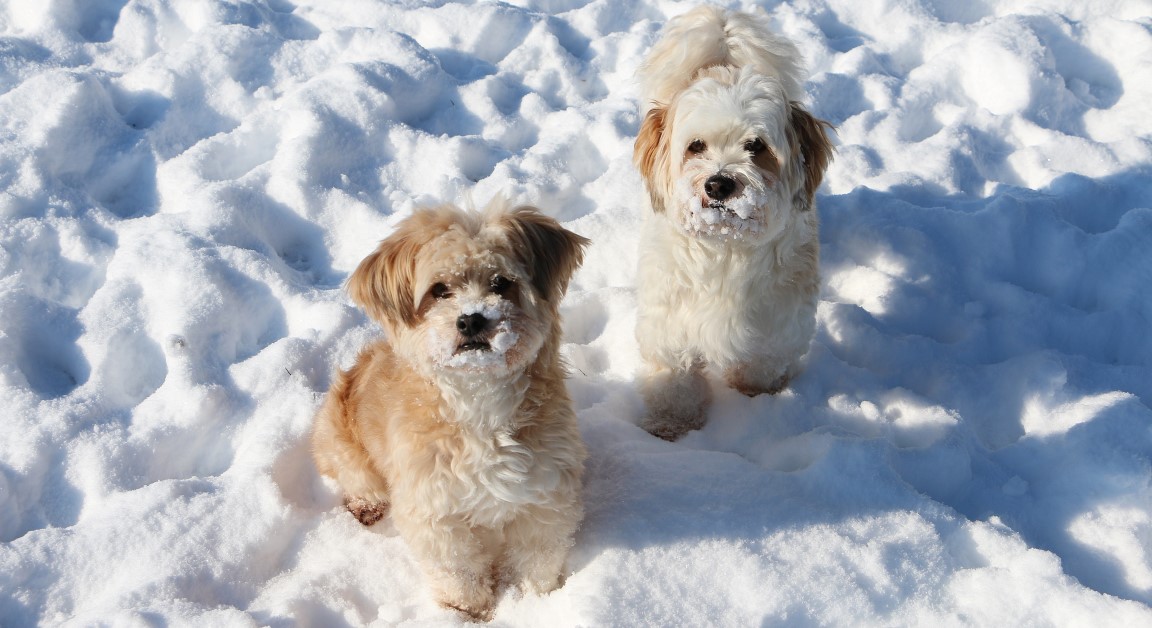Protect Your Dog’s Paws from Ice and Snow
Protect your dog’s paws this winter with these simple tips for preventing irritation and injury from icy temperatures.

If Jack Frost is nipping at your nose, you can bet that your dog’s paws are also feeling frosty. Snow, ice, and cold temperatures can be harsh on paws, especially with long-term exposure. Over time, your pet’s paws could become chapped, and they may develop dry, itchy skin. The chemicals found in many melting salts can also irritate your pet’s paws, causing potential injuries and even burns. Fortunately, there are many ways to protect your dog’s paws this winter.
Tips to Protect Dog Paws in Winter
1. Limit Exposure
One of the best ways to keep your dog’s paw pads safe in the winter is by limiting their exposure to cold, snow, and ice. Many people are under the misconception that a dog’s fur will keep it warm outside. While this is partially true depending on the breed, your dog’s paws can become frostbit, and exposed areas of skin can result in hyperthermia. A good rule of thumb is to allow your dog outdoors while he’s running and playing. However, bring him indoors once he’s stopped.
2. Wash Your Dog’s Paws After Walks
Many people continue to walk their dogs throughout the winter. However, it’s important to consider potential risks, such as melting salts on roads, sidewalks, and walkways. To remove salt and chemicals from your pet’s paws, wash them thoroughly in a small bowl of warm water after every walk. This will help prevent buildup on your pet’s paws and stop your dog from tracking these chemicals into your home.
3. Groom Your Dog Regularly
To ensure that your dog is winter-ready, engage in regular grooming sessions. Long-haired dogs may need the hair on their paws trimmed to prevent salt crystals, ice, and melting salt chemicals from clinging to their skin. Be sure to get the hair that grows between the toes of certain breeds. You’ll also want to give your pet the occasional bath to wash away any chemicals or debris that may have splashed onto your dog’s body during walks or outside play. Thoroughly dry your pet after baths to keep him warm and comfortable.
4. Moisturize and Hydrate Paw Pads
Spending time outdoors in the winter can leave your pet’s paws feeling dry and irritated. One way to restore moisture to dry, itchy paw pads is with a vet-approved paw pad balm. These dog-safe moisturizers act as a barrier to help keep out harmful chemicals during walks. If you don’t have a balm on hand, petroleum jelly will also do in a pinch. You’ll also want to keep your pet’s entire body hydrated by providing access to a fresh supply of water. Running a humidifier indoors can also help with dryness.
5. Invest in Dog Booties
Dog boots or booties are a form of dog-friendly footwear that can protect your pet’s paws from ice, snow, salt, and chemicals. Similar to human shoes, dog boots slide onto your pet’s paws and are made from tough materials that are resilient to winter hazards. When shopping for dog booties, be sure to get the appropriate size for your dog. You don’t want the boots too small to restrict blood flow, but you also don’t want them so loose that they’ll easily slide off. It may take time for your pet to get used to wearing boots, but the effort will be worth it.
6. Keep Your Pet’s Nails Trimmed
It can be easy to forget to trim your dog’s nails regularly. However, dog nails that get too long force your pet to walk with their toes more splayed apart, leaving the regions between the toes vulnerable to irritation and injury. Ideally, dogs should have their nails trimmed about every three to four weeks.
7. Bring Along a Towel on Walks
When planning extended walks or hikes with your dog in the winter, you’ll want to be prepared to care for your pet while away from home. This means bringing all of the items you need to protect your pet’s paws with you. Consider packing a towel for the trip which can be used to brush away ice melt and dry wet, icy paws.
8. Keep an Eye Out for Hazards
Winter weather presents many hazards that could potentially harm your dog. To minimize these risks, carefully monitor your environment when walking your dog or playing outdoors. For example, you’ll want to avoid areas where there are broken-up pieces of ice that could potentially stab or cut your pet’s paws. Also, look for ice patches that could pose a slip-and-fall risk for your pet.
9. Warm Up Your Dog’s Entire Body
Keeping your pet’s entire body warm can also keep their paws warm. When going outside in the winter, warm your pet’s core with a dog sweater or jacket. If your dog’s core temperature is warm, it’s easier for their body to maintain healthy circulation to the paws. It’s also important to bring your pet indoors every 15 to 20 minutes to warm up.
Protecting Your Pet’s Paws in the Winter
While some dog breeds, such as Malamutes and Huskies, are quite content spending time in the snow, short-haired breeds are less winter-adapted. In addition, all dog breeds are at risk due to ice melt chemical exposure and sharp ice fragments. If you take the appropriate steps to protect your pet this winter, you and your pet can enjoy a safe and fun winter season!.
Ready to start saving money on pet wellness care?
Then take a look at Mint Wellness, the pet wellness plan that provides fast reimbursement on routine pet care. Save on vaccinations, wellness exams, preventatives, dental, and more!
Learn More


